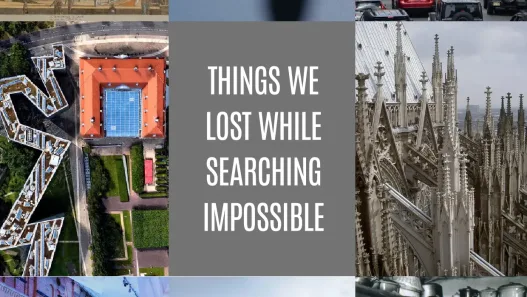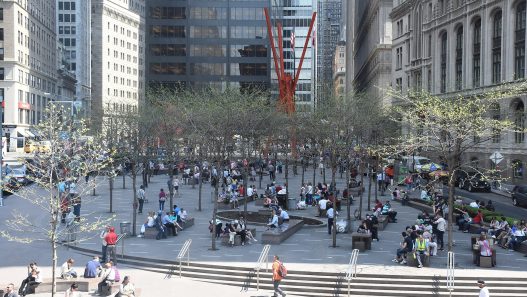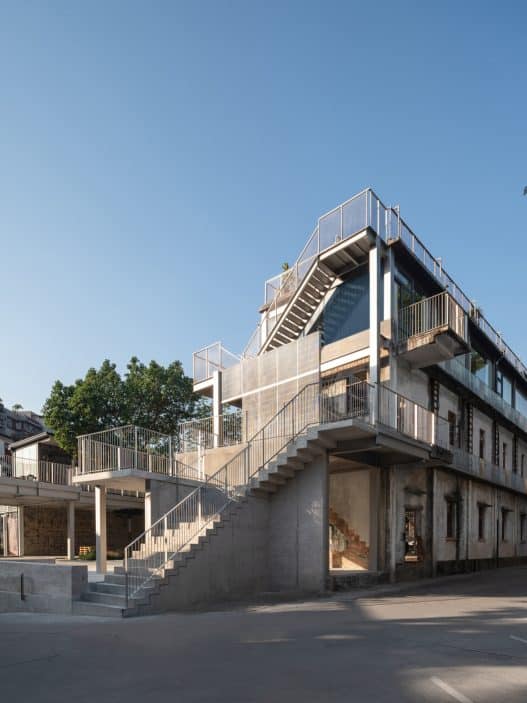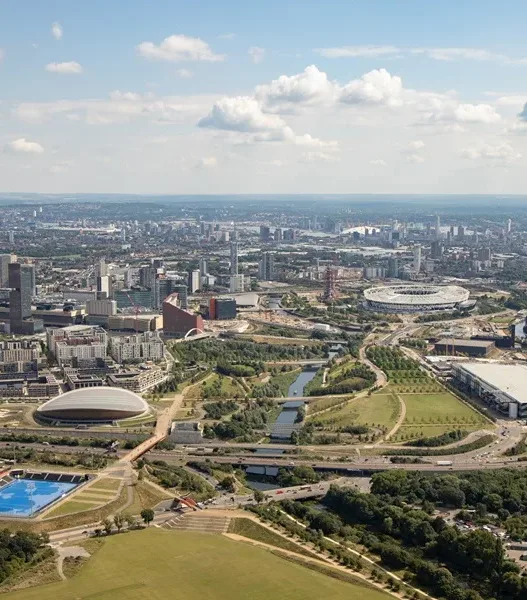This summer, an unprecedented heatwave swept across Europe, affecting millions of people and leaving an indelible mark on the continent’s architecture and urban planning. This extraordinary climate event highlighted the urgent need for sustainable design practices in a world increasingly vulnerable to climate change. As temperatures soar, the heatwave has transformed the way architects approach building design, prioritizing not just aesthetics but also the health and comfort of occupants in an era of rising global temperatures.

Heat Wave Overview
In the summer of 2003, Europe experienced one of its hottest summers on record, with temperatures exceeding 100 degrees Fahrenheit (100 degrees Celsius) in many regions. Countries such as France, Germany and Italy were particularly affected, turning cities into sweltering environments that strained both infrastructure and public health systems. The heat wave resulted in over 70,000 heat-related deaths, with vulnerable populations such as the elderly disproportionately affected. This alarming toll served as a wake-up call for governments and communities to reexamine how their built environments interact with extreme weather conditions.
Impact on Architecture
The serious consequences of the heat wave went far beyond the immediate health concerns; they profoundly influenced architectural design philosophy. Traditional building methods often failed to provide adequate relief from extreme heat, leading to uncomfortable living conditions. Architects began to recognize the need for designs that could withstand not only the heat but also other climate-related challenges. Concepts such as natural ventilation, green roofs, and heat-reflective materials gained popularity as essential components of modern architecture, representing a shift toward designs that were in harmony with the natural environment.
Reactions from the Architecture Community
In response to the devastating effects of the heat wave, the architectural community came together to address the urgent need for sustainable and resilient design solutions. Workshops, conferences, and collaborative projects have emerged that bring together architects, urban planners, and environmental scientists. This collective effort has emphasized the integration of sustainable practices into urban planning, advocating designs that not only reduce heat but also improve the overall quality of life. Transforming public spaces to include more greenery, shade, and water features are notable examples of how they help cool urban environments and create more livable conditions.
Key Statistics
The statistics surrounding the heatwave are striking and telling. In addition to the tragic loss of life, the heatwave caused significant economic damage, including losses in agriculture and increased energy consumption due to air conditioning demands. Cities reported spikes in electricity use, often leading to power outages and further stress on urban infrastructure. These figures underscore the urgent need for designs that can reduce the impact of such extreme weather events in the future. For example, studies have shown that urban areas can be up to five degrees Celsius hotter than surrounding rural areas due to the heat island effect, highlighting the critical role of thoughtful urban design in reducing heat effects.
Long-Term Impacts on Urban Planning
The long-term effects of the heatwave on urban planning have been profound. Many cities have adopted stricter building codes that prioritize energy efficiency and sustainability. The concept of “green cities” has gained momentum, leading to initiatives that promote urban forestry, sustainable drainage systems, and pedestrian-friendly designs. These strategies aim to create environments that are not only resilient to the heat, but also increase biodiversity and improve air quality. Cities that suffered greatly from the heatwave, such as Paris, have since implemented extensive programs to increase green space and promote sustainable transportation options. The legacy of the heatwave is evident in the ongoing evolution of urban landscapes as societies seek to build environments better equipped to cope with the challenges of climate change.
As a result, the European heatwave was a significant turning point in the history of architecture and urban planning. It was a catalyst for change, leading to a rethinking of how buildings are designed and how cities function. The lessons learned from this event continue to influence sustainable design practice today, highlighting the importance of creating spaces that are not only beautiful but also resilient and sustainable in the face of an uncertain climate future.
# Sustainable Design Emerges In The Aftermath Of The European Heat Wave
The heatwave in Europe has been a wake-up call for many. It has highlighted the urgent need to rethink how we design and build our environment. With temperatures rising and the impacts of climate change becoming increasingly apparent, architects and planners are beginning to explore sustainable design as a viable solution. This shift aims not only to address the immediate impacts of extreme weather, but also to create a built environment that is in harmony with nature.
Principles of Sustainable Architecture
Definition of Sustainable Architecture
Sustainable architecture refers to the design of buildings that prioritize environmental stewardship, resource efficiency, and the well-being of occupants. It encompasses a holistic approach that integrates social, economic, and environmental considerations. Essentially, it aims to improve the quality of life of occupants while minimizing the negative impact of buildings on the environment. This approach encourages in-depth consideration of materials, energy use, and the relationship between a building and its surrounding ecosystem.
Basic Principles and Concepts
At the core of sustainable architecture are several key principles. One of the main concepts is energy efficiency, which focuses on reducing energy consumption through smart design and technology. This includes natural lighting, efficient heating and cooling systems, and the use of renewable energy sources such as solar panels. Another key principle is resource conservation, which involves choosing sustainable materials that are locally sourced and have a lower environmental impact.
In addition, sustainable architecture emphasizes the importance of water management. Implementing rainwater harvesting systems and using drought-tolerant landscaping can significantly reduce water consumption. Additionally, sustainable designs often promote biodiversity with green roofs and native plants, creating habitats for local wildlife.
The idea of adaptability is also very important. Buildings should not only meet current needs, but also be flexible enough to accommodate future changes. This foresight can extend the life of a building and ultimately save resources by reducing the need for new construction.
Benefits of Sustainable Design
The benefits of sustainable design go beyond just environmental benefits. One important outcome is cost savings over time. While the initial investment in sustainable materials and technologies may be higher, the long-term savings in energy bills and maintenance costs can be significant. Additionally, buildings designed with sustainability in mind often improve indoor air quality, creating healthier living and working environments.
Sustainable architecture can also enhance the aesthetic value of a space. By integrating natural elements and prioritizing harmony with the environment, these buildings can create a more welcoming atmosphere for both occupants and visitors. On a broader scale, communities that embrace sustainable design can promote social equity and resilience, and better prepare them for future environmental challenges.
Challenges in Implementation
Despite its numerous benefits, implementing sustainable architecture presents its own challenges. One major barrier is the perception of cost. Many clients and builders view sustainable materials and technologies as expensive, often ignoring the long-term savings they can provide. Additionally, a lack of awareness and education about sustainable practices can hinder widespread adoption.
Regulatory barriers can also present challenges. Building codes and zoning laws may not always support innovative sustainable practices, creating hurdles for architects and builders trying to implement new ideas. Additionally, finding skilled labor familiar with sustainable techniques can be difficult, limiting the potential for high-quality construction.
Another key challenge is the need for collaboration among a variety of stakeholders, including architects, engineers, and community members. Effective sustainable design often requires input and collaboration from multiple disciplines, which can be difficult to coordinate.
Case Studies of Successful Projects
Many projects around the world exemplify the successful application of sustainable architecture. One notable example is Bosco Verticale, or "Vertical Forest", in Milan, Italy. This residential complex includes two towers adorned with more than 9,000 trees and 20,000 plants, creating a micro-ecosystem that improves air quality and reduces heat in the urban environment.
Another inspiring project is the Edge in Amsterdam, often considered one of the greenest office buildings in the world. The design incorporates the latest energy-efficient technologies and ensures a minimal carbon footprint. Its innovative features, such as an extensive roof garden and solar panels, demonstrate how modern architecture can effectively blend sustainability with functionality.
In the US, the Bullitt Center in Seattle has gained international recognition for its commitment to sustainability. Often referred to as the "greenest commercial building", the building is designed to run entirely on renewable energy and features a rainwater harvesting system to meet all of its water needs. The building is a model for future developments, demonstrating that sustainable architecture is not only feasible but also desirable.
As a result, there has been a significant shift towards sustainability in architectural practice following the heatwave in Europe. By understanding the principles, benefits and challenges of sustainable design, we can create a future where buildings not only coexist with nature but also actively contribute to its preservation. Through successful case studies, we see that sustainable architecture is not just a theoretical concept; it is a practical approach that can lead to healthier, more resilient societies.
# Sustainable Design Emerges In The Aftermath Of The European Heat Wave
The summer season, particularly in Europe, marked a turning point in architectural design as an unprecedented heatwave claimed thousands of lives and exposed the fragility of urban environments. This climate crisis has highlighted the urgent need for more sustainable and resilient design practices. In response, architects and builders have begun to rethink how buildings are designed, built, and integrated into their environments. The result is a rich tapestry of innovative materials and techniques that prioritize sustainability, efficiency, and the well-being of both people and the planet.
Innovative Materials and Techniques
The search for sustainability in architecture has led to increased creativity in the development and use of materials. Architects are increasingly focusing on both the environmental impact and life cycle of materials used in construction. This shift has also brought about a shift from traditional, resource-intensive materials to more sustainable, often locally sourced ones. For example, the use of reclaimed wood not only reduces waste, but also adds character and history to new buildings. Similarly, innovations in concrete, such as the use of recycled aggregates and carbon capture technology, are reducing the carbon footprint of one of the world’s most widely used building materials.
Additionally, the integration of bioplastics and mycelium derived from mushrooms has opened up exciting possibilities for lightweight, biodegradable building materials. These innovations are not only reducing environmental impact, but are also inspiring a new aesthetic in architecture that blends functionality with nature. This embrace of innovative materials is a testament to the architectural community’s commitment to redefining the way we build and live.
Environmentally Friendly Building Materials
Eco-friendly building materials are at the forefront of sustainable design. These materials are often derived from renewable resources and ensure that the ecological balance is maintained. Bamboo, for example, is rapidly renewable and grows much faster than traditional hardwoods. Its strength-to-weight ratio makes bamboo an excellent choice for both structural elements and decorative cladding.
Another example is the use of insulation made from recycled paper or denim, which not only provides thermal comfort but also diverts waste from landfills. Additionally, low-VOC (volatile organic compound) paints and coatings improve indoor air quality, creating healthier living environments. These materials reflect a growing awareness of the need to create spaces that enhance the quality of life for their occupants while minimizing environmental damage.
Passive Design Strategies
Passive design strategies are a cornerstone of sustainable architecture, which focuses on maximizing natural resources to minimize energy consumption. By carefully considering a building’s orientation, layout, and materials, architects can create spaces that naturally regulate temperature and light. For example, strategically placed windows can help capture sunlight in the winter and provide shade in the summer, reducing reliance on artificial heating and cooling systems.
The application of thermal mass (materials that absorb and store heat) further increases energy efficiency. Buildings designed with thick walls made of stone or concrete can maintain consistent indoor temperatures, providing comfort without excessive energy use. These techniques show how thoughtful design can lead to buildings that are not only more sustainable, but also more comfortable and inviting.
Renewable Energy Solutions
Renewable energy solutions have become a vital component of sustainable architecture. Solar panels are perhaps the most well-known example, converting sunlight into electricity and significantly reducing a building’s carbon footprint. Many modern designs seamlessly incorporate solar technology into architecture, whether through roof panels or integrated solar facades that blend aesthetics with functionality.
Although less common in urban environments, wind turbines are also being explored as a way to harness natural energy. These innovations are often combined with energy storage systems, allowing buildings to maintain energy independence and flexibility in the face of fluctuations in energy supply. Integrating renewable energy solutions not only helps combat climate change, but also empowers communities to take responsibility for their energy use.
Water Saving Technologies
Water conservation technologies are especially important in the context of sustainable design, as global water scarcity becomes an increasingly urgent issue. Architects are implementing systems that not only reduce water consumption but also encourage water recycling and reuse. For example, rainwater harvesting systems capture and store rainwater for irrigation or non-potable uses, significantly reducing the demand on municipal water supplies.
Greywater recycling systems, which purify water from sinks and showers and reuse it for irrigation, are becoming standard in new construction. These technologies not only conserve freshwater, they also educate residents about sustainable water use. The use of permeable paving materials allows rainwater to infiltrate the soil, reducing runoff and encouraging groundwater recharge. Such innovations exemplify a holistic approach to water management in architecture.
Intelligent Building Systems
The rise of smart building systems represents a significant advance in sustainable design. These systems use technology to optimize energy use, increase occupant comfort, and simplify building management. Sensors and automated controls allow real-time monitoring of energy consumption and adjustment of lighting and heating based on occupancy and natural light levels.
For example, smart thermostats learn the habits of building occupants to optimize heating and cooling schedules for maximum efficiency. Additionally, integrated building management systems can monitor water usage, air quality, and other critical factors, providing data for further improvements. By leveraging technology, architects and builders can create spaces that are not only responsive to their occupants but also significantly reduce their environmental impact.
As a result, the aftermath of the heatwave in Europe has seen a profound transformation in architectural design. A focus on sustainable design has led to innovative materials and techniques that prioritize ecological responsibility, energy efficiency, and occupant well-being. As we continue to confront the challenges of climate change, the lessons learned from this pivotal moment in history will guide us toward a more sustainable future in architecture.
# Sustainable Design Emerges In The Aftermath Of The European Heat Wave
The heatwave in Europe has been a wake-up call for many countries, highlighting the urgent need for sustainable design in architecture. With temperatures rising and the impacts of climate change becoming increasingly apparent, architects and planners are rethinking how buildings are designed, constructed and integrated into their environment. This shift towards sustainability aims not only to reduce the impact of extreme weather conditions, but also to create healthier spaces for both people and the planet.
Effective Architectural Projects After the Heat Wave
In the years following the heat wave, several architectural projects emerged as pioneers of sustainable design. These projects were not simply responses to the immediate crisis, but part of a broader movement toward architectural innovation that prioritized energy efficiency, resource conservation, and environmental stewardship. The emphasis on sustainability in architecture has become a critical aspect of urban planning, affecting how societies develop and adapt to changing climates.
Important Buildings and Structures
Notable buildings that exemplify this shift include the Bosco Verticale, or Vertical Forest, in Milan, Italy. Completed in 2014, this pair of residential towers combines thousands of trees, plants, and shrubs to create a vertical ecosystem that helps reduce urban heat and improve air quality. The design not only addresses the need for green space in dense urban environments, but also provides residents with a direct connection to nature that is often missing in city life.
Another notable project is the Eden Project in Cornwall, England. This ecological park features biomes that contain a variety of plant species from a variety of global climates. Opened in 2001, the park serves as an educational center that demonstrates the importance of biodiversity and sustainable practices. The project emphasizes the role of design in environmental awareness by showing how architecture can harmonize with the natural world.
Architects Leading the Change
The architects behind these transformative projects are equally important to the sustainable design narrative. Visionaries like Stefano Boeri, who designed Bosco Verticale, are at the forefront of integrating nature into urban architecture. Boeri’s philosophy emphasizes the need for buildings that not only serve functional purposes but also enhance the ecological health of their surroundings.
Similarly, Sir Tim Smit, co-founder of the Eden Project, has been instrumental in promoting sustainability through innovative design and community engagement. His work highlights the connection between architecture, education and environmental responsibility, inspiring a new generation of architects to consider the wider impact of their designs.
Community Participation and Interaction
Sustainable design is not just the job of architects and engineers; community engagement plays a vital role in successful projects. Involving local residents in the design process fosters a sense of ownership and ensures that buildings meet the needs of those who will use them. For example, projects such as the High Line in New York have been successful because of community advocacy and engagement. This elevated linear park transformed an abandoned railroad into a vibrant public space, demonstrating how community-focused design can create sustainable urban environments.
By engaging communities, architects can bring together diverse perspectives and ideas, resulting in more inclusive and impactful designs. This collaboration not only increases the functionality of spaces, but also strengthens community ties and encourages a collective commitment to sustainability.
Comparative Analysis of Projects
An examination of these influential projects reveals both common principles and unique approaches to sustainable design. For example, Bosco Verticale focuses on vertical gardening to combat urban heat, while the Eden Project emphasizes biodiversity through extensive greenhouse structures. But both projects exemplify the importance of integrating nature into urban planning.
Another comparison can be made between the High Line and Bosco Verticale. Both projects prioritize green spaces, but their contexts are different; one reclaims urban infrastructure, the other brings greenery to high-rise housing. This diversity of approaches underscores the adaptability of sustainable design to a variety of environments and community needs.
Lessons Learned from Each Project
The aftermath of the heatwave has taught architects valuable lessons about the importance of flexibility and adaptability in design. Bosco Verticale demonstrates the potential of biophilic design to enhance urban living, while the Eden Project highlights the power of education to promote sustainability. And community-focused projects like the High Line show that engaging local voices can lead to more successful and beloved public spaces.
These lessons extend beyond architecture, establishing a foundation for future developments by emphasizing that sustainability is not just a trend but a necessary paradigm shift. Through innovative design, community engagement, and commitment to ecological principles, architects can help shape a more sustainable future, prepare cities for the challenges of climate change, and foster environments that nourish both people and the planet.
# Sustainable Design Emerges In The Aftermath Of The European Heat Wave
The European heatwave marked a turning point in how cities approached design and development. Temperatures soared, leading to health crises and highlighting the vulnerability of urban environments to extreme weather. In response, the concept of sustainable design—aiming to create buildings and spaces that enhance human well-being while minimizing environmental impact—grew in popularity. This shift wasn’t just about aesthetics; it was about flexibility, efficiency, and a commitment to a healthier planet.
Government Policies and Regulations
In the wake of the heatwave, governments across Europe have recognised the urgent need for effective policies to combat climate change and promote sustainable practices. This has led to a flurry of new regulations aimed at reducing carbon footprints and improving energy efficiency in buildings. Policies focused on limiting greenhouse gas emissions and promoting renewable energy sources have become central to urban planning.
A key piece of legislation was the European Union Energy Performance of Buildings Directive, which set minimum energy performance standards for new construction and major renovations. This directive encouraged countries to adopt regulations requiring buildings to be more energy efficient and better able to cope with extreme weather events. Governments began to embrace the idea that buildings should be designed not just for comfort and beauty, but also for sustainability and durability.
Incentives for Sustainable Buildings
To further encourage sustainable design, many governments have introduced financial incentives. Grants, tax breaks, and low-interest loans have become tools to motivate builders and homeowners to invest in energy-efficient technologies. For example, programs supporting the installation of solar panels or green roofs have developed in countries such as Germany, making it economically viable for both individuals and businesses to adopt these practices.
These incentives were crucial in changing public perceptions of sustainable building. Not only did they make green technologies more accessible, they also demonstrated a commitment to a healthier environment. As people began to see the financial and environmental benefits, the idea of sustainable design began to permeate the mainstream consciousness, affecting everything from individual homes to large-scale urban developments.
Impact on Urban Development
The impact of sustainable design practices can be seen in urban development projects across Europe. Cities have begun to rethink their layouts by integrating green spaces, improving public transport and building energy-efficient buildings. The focus has shifted from sprawling suburbs to denser, mixed-use developments that reduce reliance on cars and encourage walking and cycling.
A great example of this transformation is the transformation of industrial areas into vibrant, eco-friendly neighborhoods. Cities like Copenhagen and Amsterdam have adopted this model, demonstrating how sustainable design can lead to more livable urban areas. These developments prioritize community well-being by providing access to parks, recreational areas, and essential services, while minimizing environmental impact.
International Standards and Agreements
The need for a consistent approach to sustainable design has transcended national boundaries, leading to the creation of international standards and agreements. Frameworks such as the United Nations Sustainable Development Goals (SDGs) have set ambitious targets for sustainability that countries strive to achieve. These goals emphasize the importance of sustainable cities and communities, and call on nations to adopt practices that enhance both environmental integrity and human health.
Additionally, organizations such as the International Organization for Standardization (ISO) have developed standards for sustainable building practices. These international benchmarks help ensure that countries can work together toward common sustainability goals, encouraging collaboration and information exchange. This interconnected approach emphasizes the global nature of climate challenges and the need for collective action.
Future Policy Directions
Looking ahead, the future of sustainable design will likely be shaped by evolving technologies and changing societal values. Policymakers are beginning to recognize the importance of integrating climate resilience into urban planning. This means not only addressing current environmental issues, but also preparing for future challenges such as rising sea levels and increasing frequency of extreme weather events.
There is also increasing interest in the concept of a circular economy, which promotes practices that reduce waste and encourage the reuse of materials. Future policies could focus on encouraging businesses and individuals to adopt circular principles, ensuring that sustainability becomes a core element of design rather than an afterthought.
As cities continue to grow and face new challenges, a commitment to sustainable design will be crucial. By learning from the past, particularly the impacts of the heatwave, we can create policies that foster resilience, protect our environment, and create vibrant communities for future generations.
# Sustainable Design Emerges In The Aftermath Of The European Heat Wave
The European heatwave was a major turning point in understanding the impact of climate change on urban life. This unprecedented event not only caused significant loss of life, but also highlighted the urgent need for sustainable design in architecture. As temperatures rose, cities struggled to cope, exposing the vulnerabilities of infrastructure and building practices. In the wake of these events, a movement towards sustainable architecture began, highlighting the need for designs that not only withstand extreme weather conditions but also promote environmental well-being. The following sections explore the future of sustainable architecture, examining emerging trends, technological developments, public awareness and global perspectives.
The Future of Sustainable Architecture
Looking to the future, we see sustainable architecture redefining our interaction with our built environment. It aims to create spaces that are not only functional but also in harmony with nature. This vision includes buildings that are energy efficient, use sustainable materials, and are designed to adapt to changing climates. Green roofs, natural ventilation, and the integration of passive solar design are just a few examples of how architects are redesigning spaces. By prioritizing sustainability, architects can create buildings that minimize carbon footprints while improving the quality of life for their occupants.
Emerging Trends and Innovations
In recent years, innovative approaches have emerged that are reshaping the landscape of sustainable architecture. One notable trend is the increasing use of biophilic design, which aims to connect building occupants with nature through natural light, greenery, and organic materials. This approach not only increases aesthetic appeal, but also promotes mental well-being. Furthermore, modular construction techniques are gaining traction, allowing for faster construction processes and less waste. These innovations are not just theoretical; they are being implemented in projects around the world, demonstrating that sustainable design can be both practical and beautiful.
The Role of Technology
Technology plays a crucial role in the development of sustainable architecture. Smart building technologies, such as energy management systems and IoT devices, allow buildings to optimize their performance by providing real-time monitoring of energy usage. Additionally, advances in material science have led to the development of eco-friendly alternatives such as recycled steel and low-VOC paints. These materials reduce environmental impact without compromising quality or safety. As technology continues to evolve, its integration into architectural practices will drive the industry toward a more sustainable future.
Public Perception and Awareness
Public perceptions of sustainability have changed significantly in recent years. As awareness of climate change increases, so has the demand for sustainable practices in architecture. Societies are increasingly advocating for greener buildings, recognizing the long-term benefits they offer. This change is evident in policy changes at the local, national and international levels, where governments have introduced regulations that encourage sustainable building practices. Educational initiatives and public campaigns have also played a vital role in promoting a culture of sustainability, empowering individuals to make informed choices about their environment.
Global Perspectives on Sustainability
Sustainability is a global issue, and different regions approach the issue from unique perspectives. In developing countries, the focus is often on affordable housing solutions that use local materials and labor, and promote economic sustainability as well as environmental considerations. In contrast, developed countries may prioritize cutting-edge technology and innovative design. Despite these differences, the common goal remains: to create resilient societies that can thrive in the face of climate challenges. Collaborative efforts, such as international summits and partnerships, are essential to sharing knowledge and resources and ultimately achieving a more sustainable world.
The result: A vision for the future
As we look to the future, the vision of sustainable architecture is one of hope and possibility. The lessons learned from the European heatwave are a reminder of the urgent need for change. By embracing innovative design, leveraging technology and raising public awareness, we can create buildings that not only meet the needs of today but also protect the future. Sustainable architecture offers a path to a healthier planet where people can live in balanced and respectful coexistence with nature. The journey may be challenging, but the potential rewards—a more sustainable and resilient world—are worth pursuing.

























